Literature Review: Understanding TB in Healthcare Workers
VerifiedAdded on 2023/06/12
|8
|1957
|320
Literature Review
AI Summary
This literature review examines the prevalence and risk factors associated with tuberculosis (TB) among healthcare workers, particularly in South Africa. It highlights the increased vulnerability of healthcare workers to TB infection due to occupational exposure, compounded by factors such as HIV/AIDS prevalence and environmental conditions. The review synthesizes findings from multiple studies, emphasizing the need for regular TB screening and preventive measures within healthcare settings. It delves into the biological aspects of Mycobacterium tuberculosis, its pathogenesis, and challenges in treatment due to drug resistance. Furthermore, the review discusses existing legislation and control programs aimed at integrating HIV and TB care, advocating for sustainable partnerships to improve healthcare services and reduce the burden of TB among healthcare professionals. This document, contributed to Desklib, offers valuable insights for students and researchers studying public health and infectious diseases.
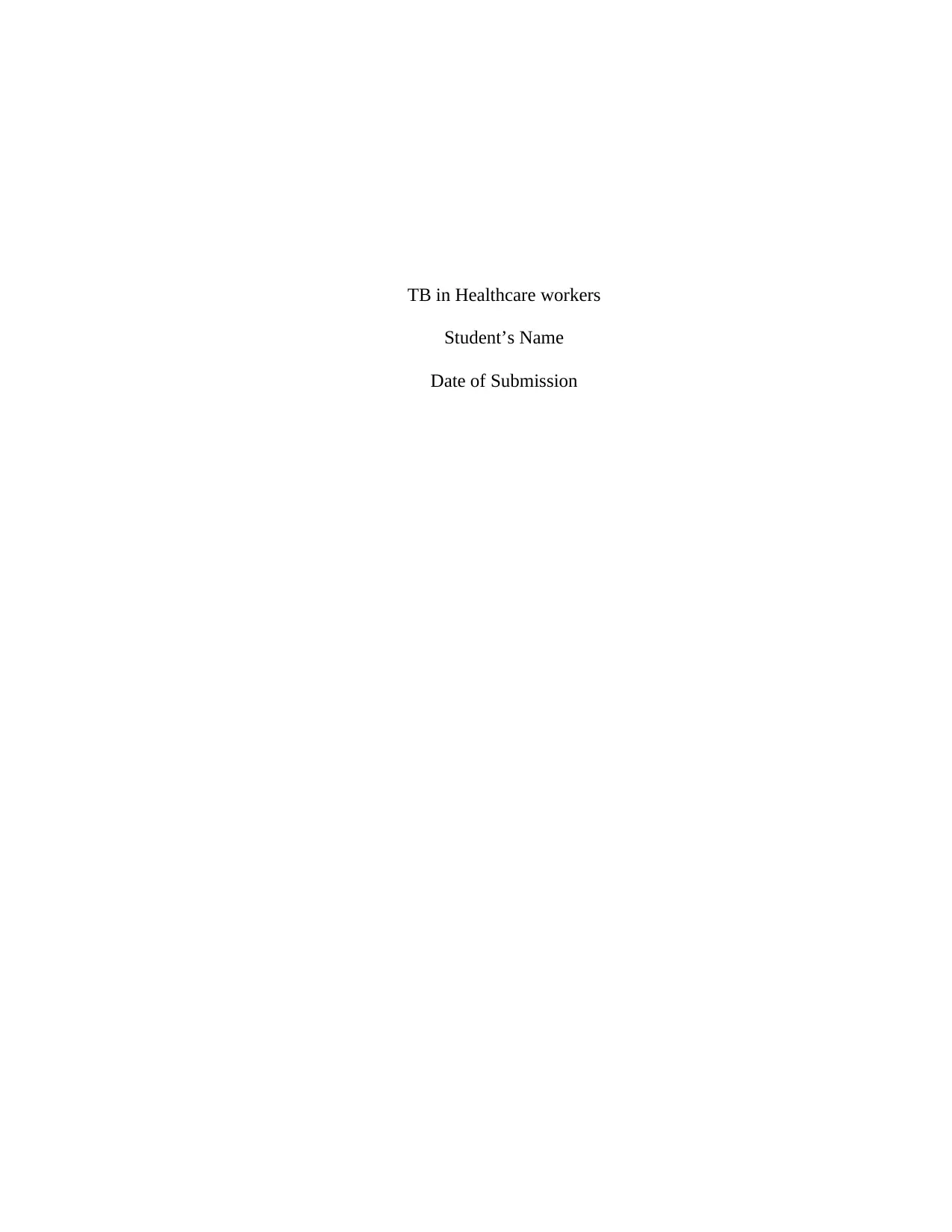
TB in Healthcare workers
Student’s Name
Date of Submission
Student’s Name
Date of Submission
Paraphrase This Document
Need a fresh take? Get an instant paraphrase of this document with our AI Paraphraser
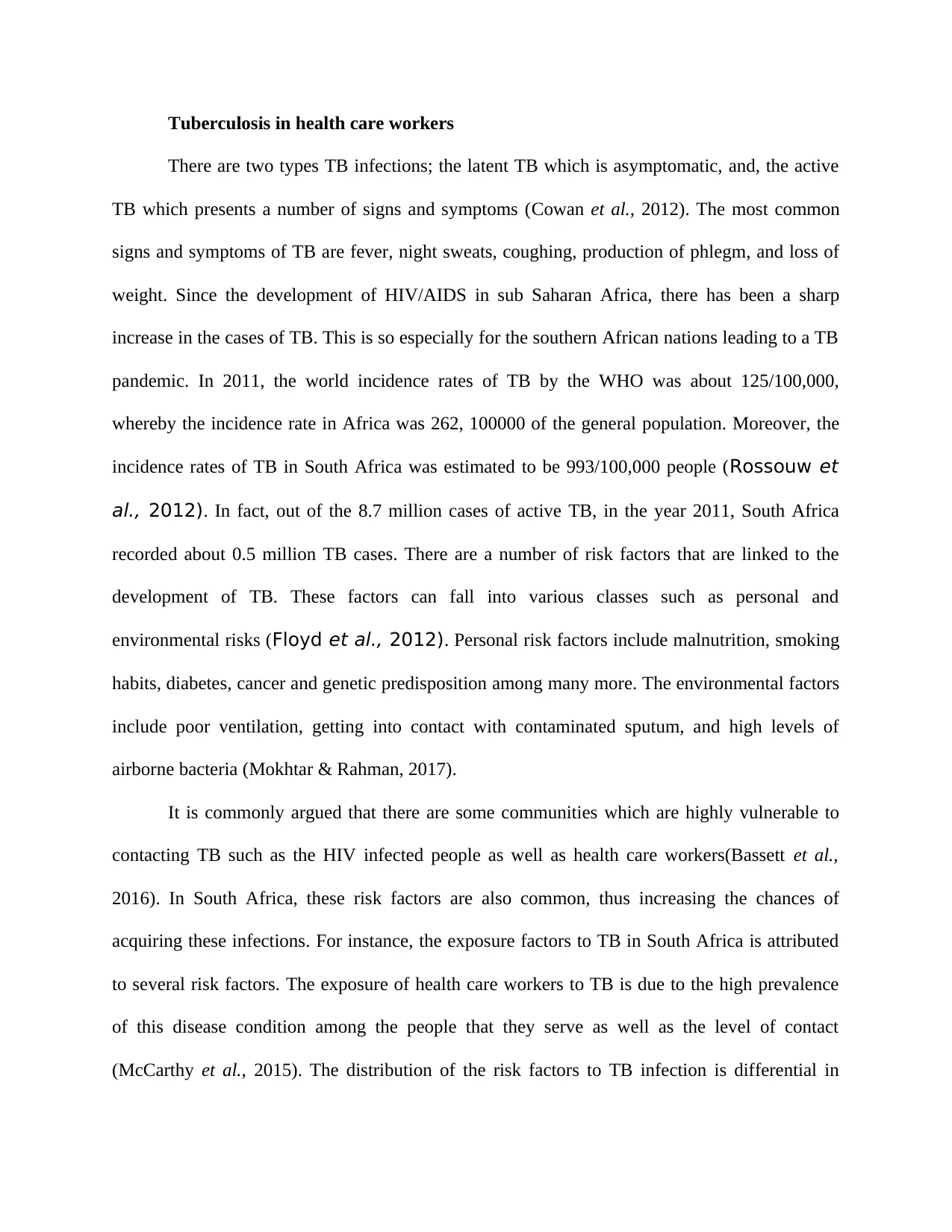
Tuberculosis in health care workers
There are two types TB infections; the latent TB which is asymptomatic, and, the active
TB which presents a number of signs and symptoms (Cowan et al., 2012). The most common
signs and symptoms of TB are fever, night sweats, coughing, production of phlegm, and loss of
weight. Since the development of HIV/AIDS in sub Saharan Africa, there has been a sharp
increase in the cases of TB. This is so especially for the southern African nations leading to a TB
pandemic. In 2011, the world incidence rates of TB by the WHO was about 125/100,000,
whereby the incidence rate in Africa was 262, 100000 of the general population. Moreover, the
incidence rates of TB in South Africa was estimated to be 993/100,000 people (Rossouw et
al., 2012). In fact, out of the 8.7 million cases of active TB, in the year 2011, South Africa
recorded about 0.5 million TB cases. There are a number of risk factors that are linked to the
development of TB. These factors can fall into various classes such as personal and
environmental risks (Floyd et al., 2012). Personal risk factors include malnutrition, smoking
habits, diabetes, cancer and genetic predisposition among many more. The environmental factors
include poor ventilation, getting into contact with contaminated sputum, and high levels of
airborne bacteria (Mokhtar & Rahman, 2017).
It is commonly argued that there are some communities which are highly vulnerable to
contacting TB such as the HIV infected people as well as health care workers(Bassett et al.,
2016). In South Africa, these risk factors are also common, thus increasing the chances of
acquiring these infections. For instance, the exposure factors to TB in South Africa is attributed
to several risk factors. The exposure of health care workers to TB is due to the high prevalence
of this disease condition among the people that they serve as well as the level of contact
(McCarthy et al., 2015). The distribution of the risk factors to TB infection is differential in
There are two types TB infections; the latent TB which is asymptomatic, and, the active
TB which presents a number of signs and symptoms (Cowan et al., 2012). The most common
signs and symptoms of TB are fever, night sweats, coughing, production of phlegm, and loss of
weight. Since the development of HIV/AIDS in sub Saharan Africa, there has been a sharp
increase in the cases of TB. This is so especially for the southern African nations leading to a TB
pandemic. In 2011, the world incidence rates of TB by the WHO was about 125/100,000,
whereby the incidence rate in Africa was 262, 100000 of the general population. Moreover, the
incidence rates of TB in South Africa was estimated to be 993/100,000 people (Rossouw et
al., 2012). In fact, out of the 8.7 million cases of active TB, in the year 2011, South Africa
recorded about 0.5 million TB cases. There are a number of risk factors that are linked to the
development of TB. These factors can fall into various classes such as personal and
environmental risks (Floyd et al., 2012). Personal risk factors include malnutrition, smoking
habits, diabetes, cancer and genetic predisposition among many more. The environmental factors
include poor ventilation, getting into contact with contaminated sputum, and high levels of
airborne bacteria (Mokhtar & Rahman, 2017).
It is commonly argued that there are some communities which are highly vulnerable to
contacting TB such as the HIV infected people as well as health care workers(Bassett et al.,
2016). In South Africa, these risk factors are also common, thus increasing the chances of
acquiring these infections. For instance, the exposure factors to TB in South Africa is attributed
to several risk factors. The exposure of health care workers to TB is due to the high prevalence
of this disease condition among the people that they serve as well as the level of contact
(McCarthy et al., 2015). The distribution of the risk factors to TB infection is differential in
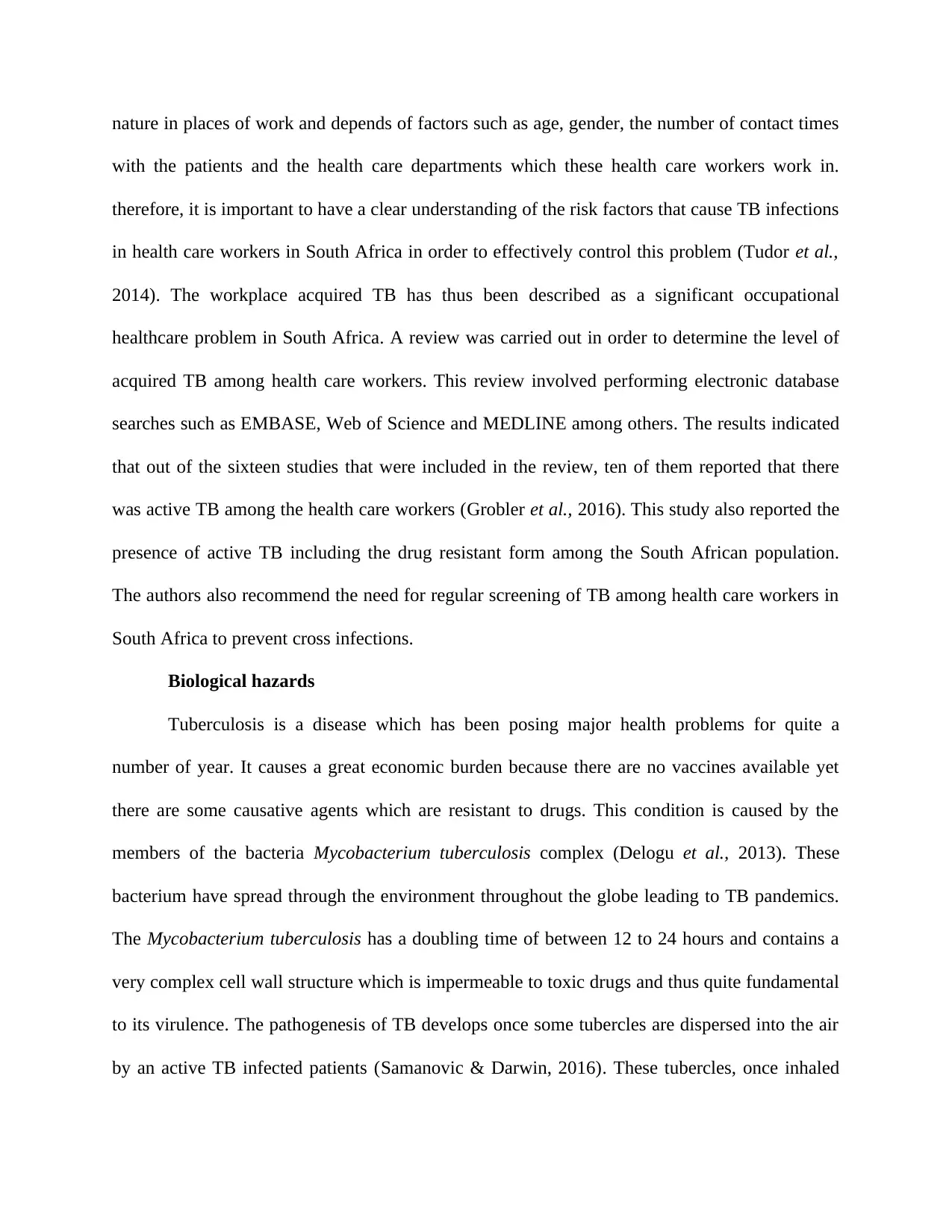
nature in places of work and depends of factors such as age, gender, the number of contact times
with the patients and the health care departments which these health care workers work in.
therefore, it is important to have a clear understanding of the risk factors that cause TB infections
in health care workers in South Africa in order to effectively control this problem (Tudor et al.,
2014). The workplace acquired TB has thus been described as a significant occupational
healthcare problem in South Africa. A review was carried out in order to determine the level of
acquired TB among health care workers. This review involved performing electronic database
searches such as EMBASE, Web of Science and MEDLINE among others. The results indicated
that out of the sixteen studies that were included in the review, ten of them reported that there
was active TB among the health care workers (Grobler et al., 2016). This study also reported the
presence of active TB including the drug resistant form among the South African population.
The authors also recommend the need for regular screening of TB among health care workers in
South Africa to prevent cross infections.
Biological hazards
Tuberculosis is a disease which has been posing major health problems for quite a
number of year. It causes a great economic burden because there are no vaccines available yet
there are some causative agents which are resistant to drugs. This condition is caused by the
members of the bacteria Mycobacterium tuberculosis complex (Delogu et al., 2013). These
bacterium have spread through the environment throughout the globe leading to TB pandemics.
The Mycobacterium tuberculosis has a doubling time of between 12 to 24 hours and contains a
very complex cell wall structure which is impermeable to toxic drugs and thus quite fundamental
to its virulence. The pathogenesis of TB develops once some tubercles are dispersed into the air
by an active TB infected patients (Samanovic & Darwin, 2016). These tubercles, once inhaled
with the patients and the health care departments which these health care workers work in.
therefore, it is important to have a clear understanding of the risk factors that cause TB infections
in health care workers in South Africa in order to effectively control this problem (Tudor et al.,
2014). The workplace acquired TB has thus been described as a significant occupational
healthcare problem in South Africa. A review was carried out in order to determine the level of
acquired TB among health care workers. This review involved performing electronic database
searches such as EMBASE, Web of Science and MEDLINE among others. The results indicated
that out of the sixteen studies that were included in the review, ten of them reported that there
was active TB among the health care workers (Grobler et al., 2016). This study also reported the
presence of active TB including the drug resistant form among the South African population.
The authors also recommend the need for regular screening of TB among health care workers in
South Africa to prevent cross infections.
Biological hazards
Tuberculosis is a disease which has been posing major health problems for quite a
number of year. It causes a great economic burden because there are no vaccines available yet
there are some causative agents which are resistant to drugs. This condition is caused by the
members of the bacteria Mycobacterium tuberculosis complex (Delogu et al., 2013). These
bacterium have spread through the environment throughout the globe leading to TB pandemics.
The Mycobacterium tuberculosis has a doubling time of between 12 to 24 hours and contains a
very complex cell wall structure which is impermeable to toxic drugs and thus quite fundamental
to its virulence. The pathogenesis of TB develops once some tubercles are dispersed into the air
by an active TB infected patients (Samanovic & Darwin, 2016). These tubercles, once inhaled
⊘ This is a preview!⊘
Do you want full access?
Subscribe today to unlock all pages.

Trusted by 1+ million students worldwide
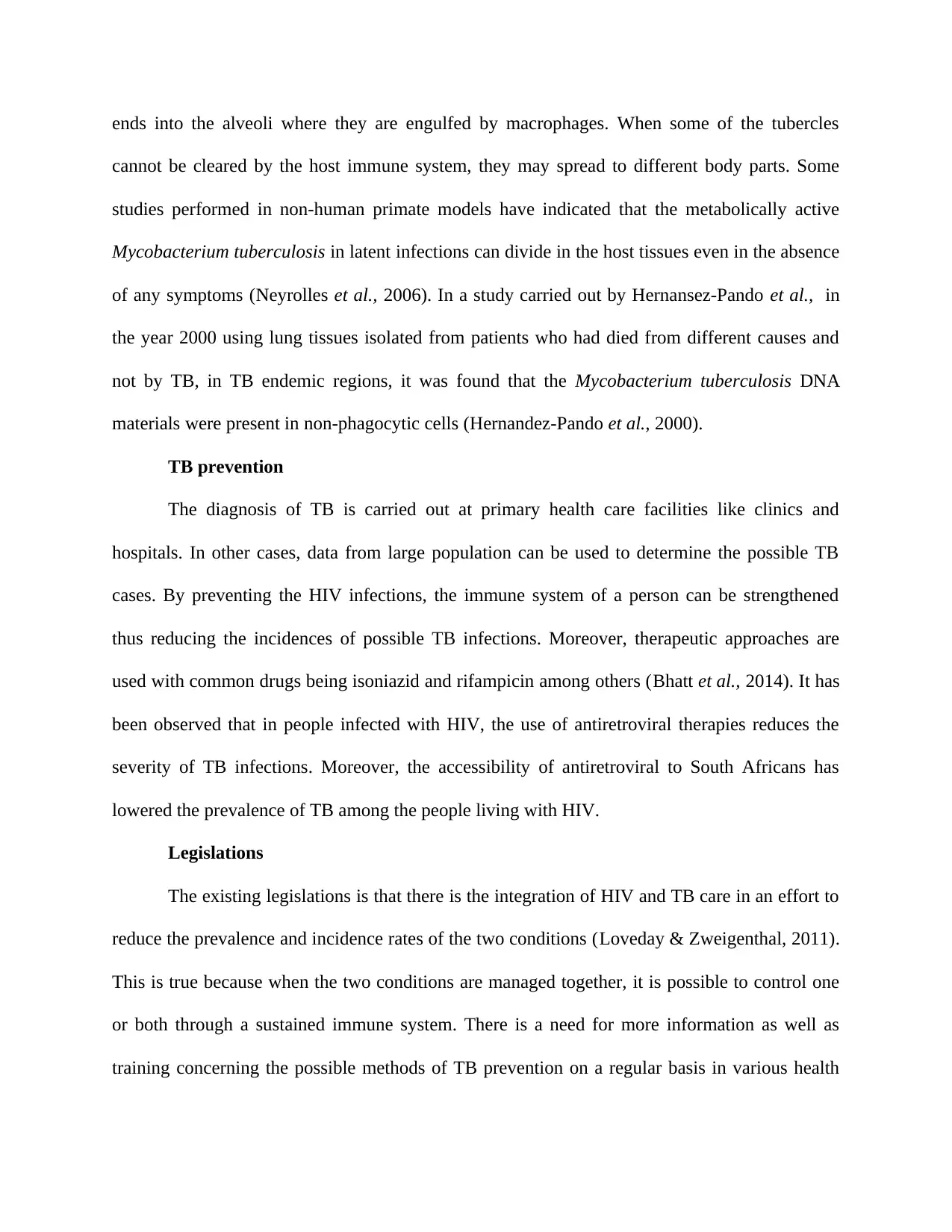
ends into the alveoli where they are engulfed by macrophages. When some of the tubercles
cannot be cleared by the host immune system, they may spread to different body parts. Some
studies performed in non-human primate models have indicated that the metabolically active
Mycobacterium tuberculosis in latent infections can divide in the host tissues even in the absence
of any symptoms (Neyrolles et al., 2006). In a study carried out by Hernansez-Pando et al., in
the year 2000 using lung tissues isolated from patients who had died from different causes and
not by TB, in TB endemic regions, it was found that the Mycobacterium tuberculosis DNA
materials were present in non-phagocytic cells (Hernandez-Pando et al., 2000).
TB prevention
The diagnosis of TB is carried out at primary health care facilities like clinics and
hospitals. In other cases, data from large population can be used to determine the possible TB
cases. By preventing the HIV infections, the immune system of a person can be strengthened
thus reducing the incidences of possible TB infections. Moreover, therapeutic approaches are
used with common drugs being isoniazid and rifampicin among others (Bhatt et al., 2014). It has
been observed that in people infected with HIV, the use of antiretroviral therapies reduces the
severity of TB infections. Moreover, the accessibility of antiretroviral to South Africans has
lowered the prevalence of TB among the people living with HIV.
Legislations
The existing legislations is that there is the integration of HIV and TB care in an effort to
reduce the prevalence and incidence rates of the two conditions (Loveday & Zweigenthal, 2011).
This is true because when the two conditions are managed together, it is possible to control one
or both through a sustained immune system. There is a need for more information as well as
training concerning the possible methods of TB prevention on a regular basis in various health
cannot be cleared by the host immune system, they may spread to different body parts. Some
studies performed in non-human primate models have indicated that the metabolically active
Mycobacterium tuberculosis in latent infections can divide in the host tissues even in the absence
of any symptoms (Neyrolles et al., 2006). In a study carried out by Hernansez-Pando et al., in
the year 2000 using lung tissues isolated from patients who had died from different causes and
not by TB, in TB endemic regions, it was found that the Mycobacterium tuberculosis DNA
materials were present in non-phagocytic cells (Hernandez-Pando et al., 2000).
TB prevention
The diagnosis of TB is carried out at primary health care facilities like clinics and
hospitals. In other cases, data from large population can be used to determine the possible TB
cases. By preventing the HIV infections, the immune system of a person can be strengthened
thus reducing the incidences of possible TB infections. Moreover, therapeutic approaches are
used with common drugs being isoniazid and rifampicin among others (Bhatt et al., 2014). It has
been observed that in people infected with HIV, the use of antiretroviral therapies reduces the
severity of TB infections. Moreover, the accessibility of antiretroviral to South Africans has
lowered the prevalence of TB among the people living with HIV.
Legislations
The existing legislations is that there is the integration of HIV and TB care in an effort to
reduce the prevalence and incidence rates of the two conditions (Loveday & Zweigenthal, 2011).
This is true because when the two conditions are managed together, it is possible to control one
or both through a sustained immune system. There is a need for more information as well as
training concerning the possible methods of TB prevention on a regular basis in various health
Paraphrase This Document
Need a fresh take? Get an instant paraphrase of this document with our AI Paraphraser
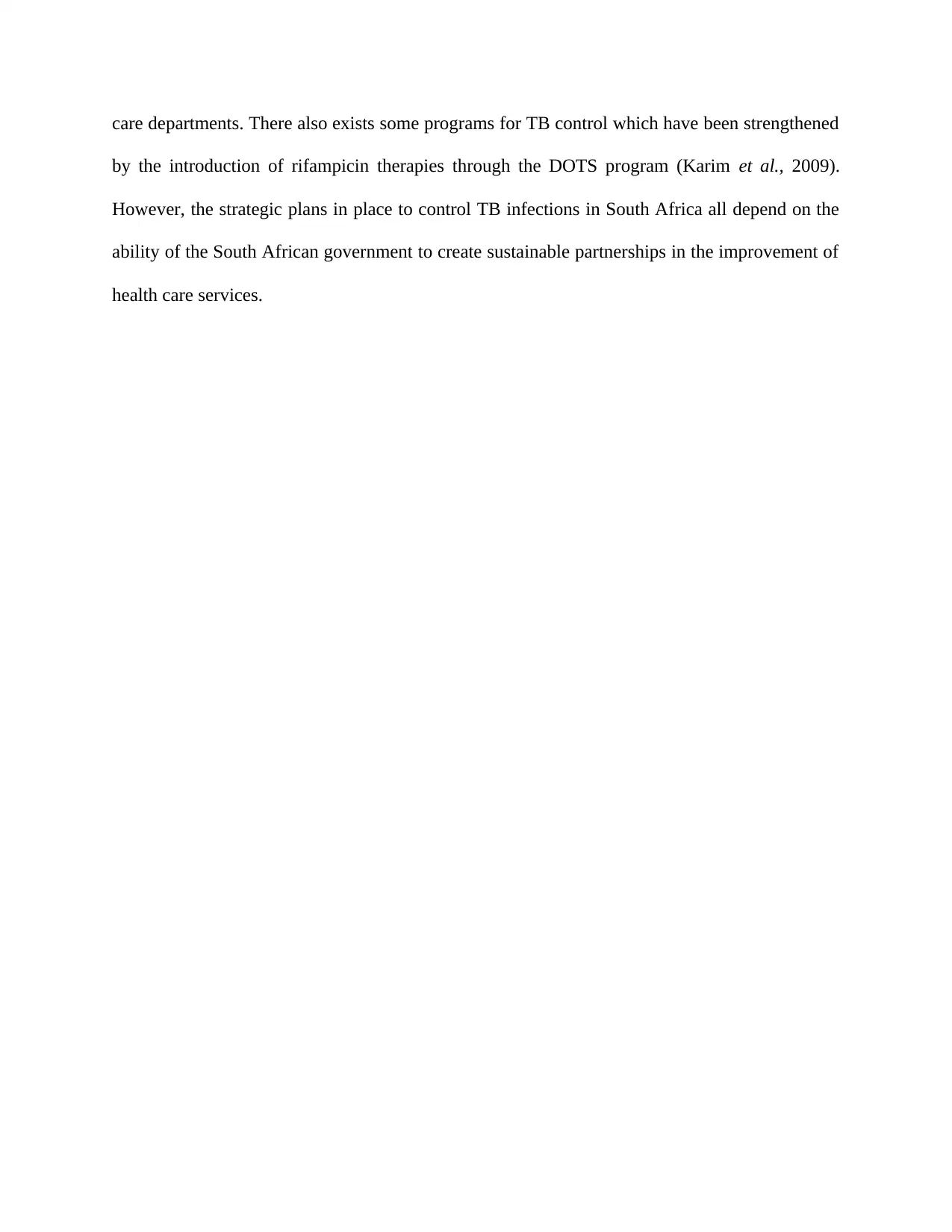
care departments. There also exists some programs for TB control which have been strengthened
by the introduction of rifampicin therapies through the DOTS program (Karim et al., 2009).
However, the strategic plans in place to control TB infections in South Africa all depend on the
ability of the South African government to create sustainable partnerships in the improvement of
health care services.
by the introduction of rifampicin therapies through the DOTS program (Karim et al., 2009).
However, the strategic plans in place to control TB infections in South Africa all depend on the
ability of the South African government to create sustainable partnerships in the improvement of
health care services.
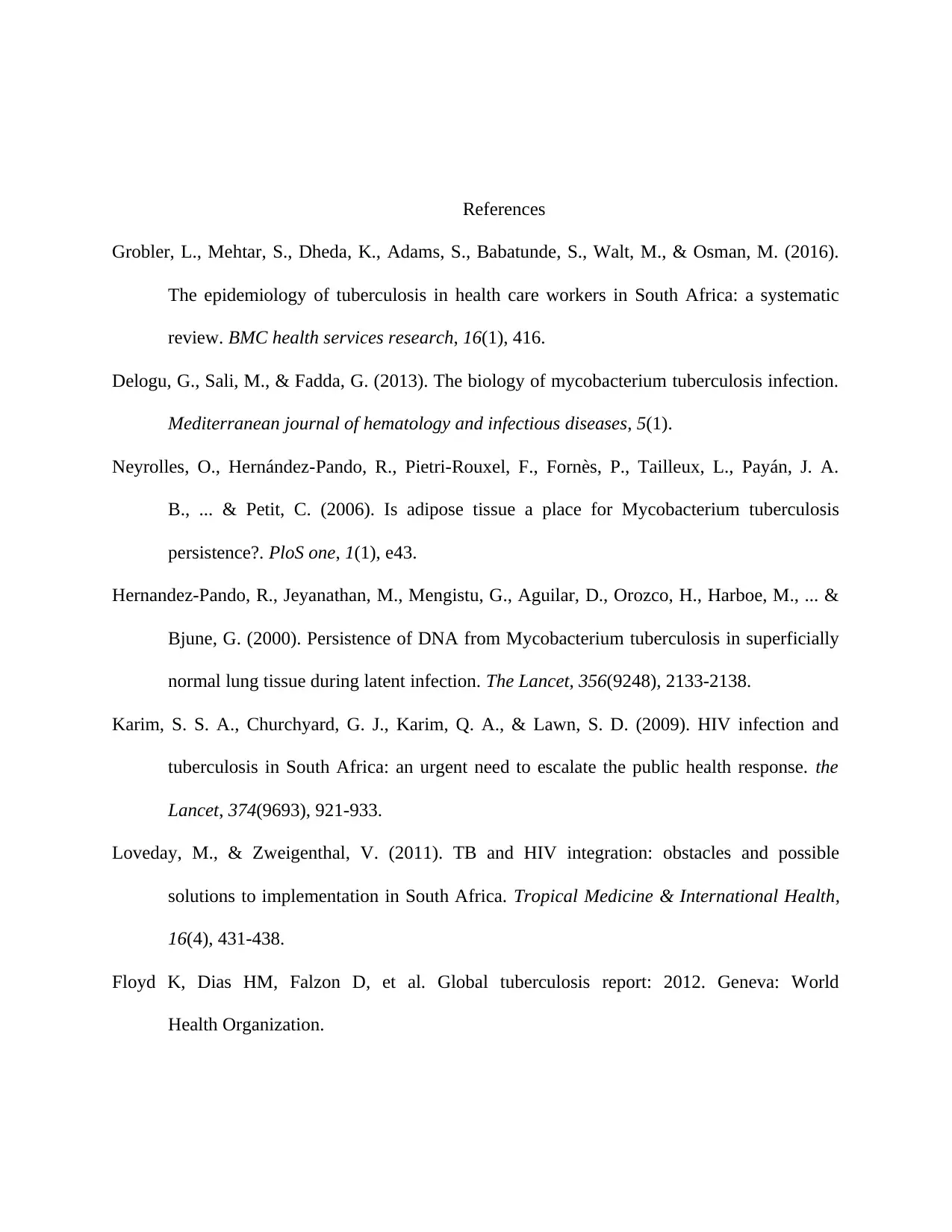
References
Grobler, L., Mehtar, S., Dheda, K., Adams, S., Babatunde, S., Walt, M., & Osman, M. (2016).
The epidemiology of tuberculosis in health care workers in South Africa: a systematic
review. BMC health services research, 16(1), 416.
Delogu, G., Sali, M., & Fadda, G. (2013). The biology of mycobacterium tuberculosis infection.
Mediterranean journal of hematology and infectious diseases, 5(1).
Neyrolles, O., Hernández-Pando, R., Pietri-Rouxel, F., Fornès, P., Tailleux, L., Payán, J. A.
B., ... & Petit, C. (2006). Is adipose tissue a place for Mycobacterium tuberculosis
persistence?. PloS one, 1(1), e43.
Hernandez-Pando, R., Jeyanathan, M., Mengistu, G., Aguilar, D., Orozco, H., Harboe, M., ... &
Bjune, G. (2000). Persistence of DNA from Mycobacterium tuberculosis in superficially
normal lung tissue during latent infection. The Lancet, 356(9248), 2133-2138.
Karim, S. S. A., Churchyard, G. J., Karim, Q. A., & Lawn, S. D. (2009). HIV infection and
tuberculosis in South Africa: an urgent need to escalate the public health response. the
Lancet, 374(9693), 921-933.
Loveday, M., & Zweigenthal, V. (2011). TB and HIV integration: obstacles and possible
solutions to implementation in South Africa. Tropical Medicine & International Health,
16(4), 431-438.
Floyd K, Dias HM, Falzon D, et al. Global tuberculosis report: 2012. Geneva: World
Health Organization.
Grobler, L., Mehtar, S., Dheda, K., Adams, S., Babatunde, S., Walt, M., & Osman, M. (2016).
The epidemiology of tuberculosis in health care workers in South Africa: a systematic
review. BMC health services research, 16(1), 416.
Delogu, G., Sali, M., & Fadda, G. (2013). The biology of mycobacterium tuberculosis infection.
Mediterranean journal of hematology and infectious diseases, 5(1).
Neyrolles, O., Hernández-Pando, R., Pietri-Rouxel, F., Fornès, P., Tailleux, L., Payán, J. A.
B., ... & Petit, C. (2006). Is adipose tissue a place for Mycobacterium tuberculosis
persistence?. PloS one, 1(1), e43.
Hernandez-Pando, R., Jeyanathan, M., Mengistu, G., Aguilar, D., Orozco, H., Harboe, M., ... &
Bjune, G. (2000). Persistence of DNA from Mycobacterium tuberculosis in superficially
normal lung tissue during latent infection. The Lancet, 356(9248), 2133-2138.
Karim, S. S. A., Churchyard, G. J., Karim, Q. A., & Lawn, S. D. (2009). HIV infection and
tuberculosis in South Africa: an urgent need to escalate the public health response. the
Lancet, 374(9693), 921-933.
Loveday, M., & Zweigenthal, V. (2011). TB and HIV integration: obstacles and possible
solutions to implementation in South Africa. Tropical Medicine & International Health,
16(4), 431-438.
Floyd K, Dias HM, Falzon D, et al. Global tuberculosis report: 2012. Geneva: World
Health Organization.
⊘ This is a preview!⊘
Do you want full access?
Subscribe today to unlock all pages.

Trusted by 1+ million students worldwide
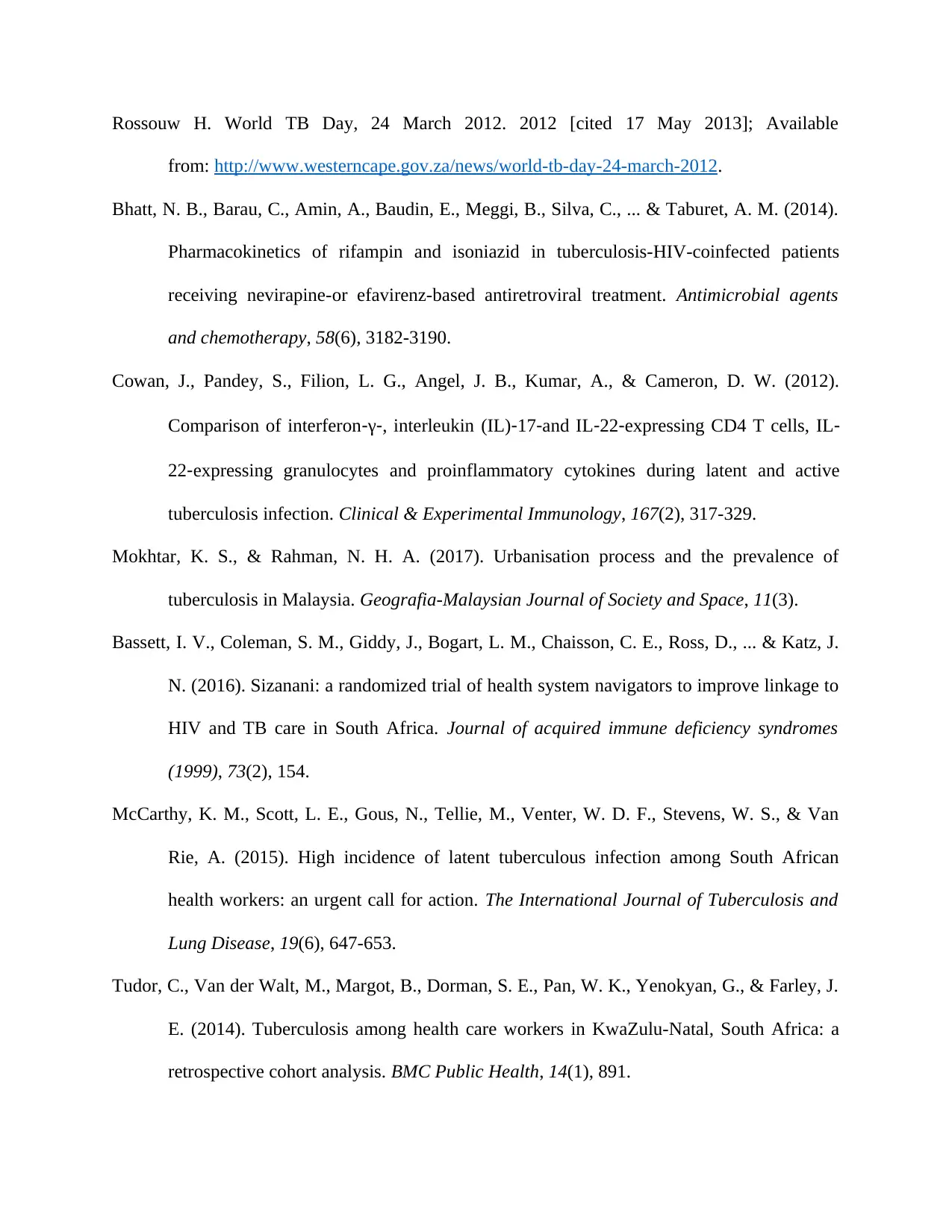
Rossouw H. World TB Day, 24 March 2012. 2012 [cited 17 May 2013]; Available
from: http://www.westerncape.gov.za/news/world-tb-day-24-march-2012.
Bhatt, N. B., Barau, C., Amin, A., Baudin, E., Meggi, B., Silva, C., ... & Taburet, A. M. (2014).
Pharmacokinetics of rifampin and isoniazid in tuberculosis-HIV-coinfected patients
receiving nevirapine-or efavirenz-based antiretroviral treatment. Antimicrobial agents
and chemotherapy, 58(6), 3182-3190.
Cowan, J., Pandey, S., Filion, L. G., Angel, J. B., Kumar, A., & Cameron, D. W. (2012).
Comparison of interferon‐γ‐, interleukin (IL)‐17‐and IL‐22‐expressing CD4 T cells, IL‐
22‐expressing granulocytes and proinflammatory cytokines during latent and active
tuberculosis infection. Clinical & Experimental Immunology, 167(2), 317-329.
Mokhtar, K. S., & Rahman, N. H. A. (2017). Urbanisation process and the prevalence of
tuberculosis in Malaysia. Geografia-Malaysian Journal of Society and Space, 11(3).
Bassett, I. V., Coleman, S. M., Giddy, J., Bogart, L. M., Chaisson, C. E., Ross, D., ... & Katz, J.
N. (2016). Sizanani: a randomized trial of health system navigators to improve linkage to
HIV and TB care in South Africa. Journal of acquired immune deficiency syndromes
(1999), 73(2), 154.
McCarthy, K. M., Scott, L. E., Gous, N., Tellie, M., Venter, W. D. F., Stevens, W. S., & Van
Rie, A. (2015). High incidence of latent tuberculous infection among South African
health workers: an urgent call for action. The International Journal of Tuberculosis and
Lung Disease, 19(6), 647-653.
Tudor, C., Van der Walt, M., Margot, B., Dorman, S. E., Pan, W. K., Yenokyan, G., & Farley, J.
E. (2014). Tuberculosis among health care workers in KwaZulu-Natal, South Africa: a
retrospective cohort analysis. BMC Public Health, 14(1), 891.
from: http://www.westerncape.gov.za/news/world-tb-day-24-march-2012.
Bhatt, N. B., Barau, C., Amin, A., Baudin, E., Meggi, B., Silva, C., ... & Taburet, A. M. (2014).
Pharmacokinetics of rifampin and isoniazid in tuberculosis-HIV-coinfected patients
receiving nevirapine-or efavirenz-based antiretroviral treatment. Antimicrobial agents
and chemotherapy, 58(6), 3182-3190.
Cowan, J., Pandey, S., Filion, L. G., Angel, J. B., Kumar, A., & Cameron, D. W. (2012).
Comparison of interferon‐γ‐, interleukin (IL)‐17‐and IL‐22‐expressing CD4 T cells, IL‐
22‐expressing granulocytes and proinflammatory cytokines during latent and active
tuberculosis infection. Clinical & Experimental Immunology, 167(2), 317-329.
Mokhtar, K. S., & Rahman, N. H. A. (2017). Urbanisation process and the prevalence of
tuberculosis in Malaysia. Geografia-Malaysian Journal of Society and Space, 11(3).
Bassett, I. V., Coleman, S. M., Giddy, J., Bogart, L. M., Chaisson, C. E., Ross, D., ... & Katz, J.
N. (2016). Sizanani: a randomized trial of health system navigators to improve linkage to
HIV and TB care in South Africa. Journal of acquired immune deficiency syndromes
(1999), 73(2), 154.
McCarthy, K. M., Scott, L. E., Gous, N., Tellie, M., Venter, W. D. F., Stevens, W. S., & Van
Rie, A. (2015). High incidence of latent tuberculous infection among South African
health workers: an urgent call for action. The International Journal of Tuberculosis and
Lung Disease, 19(6), 647-653.
Tudor, C., Van der Walt, M., Margot, B., Dorman, S. E., Pan, W. K., Yenokyan, G., & Farley, J.
E. (2014). Tuberculosis among health care workers in KwaZulu-Natal, South Africa: a
retrospective cohort analysis. BMC Public Health, 14(1), 891.
Paraphrase This Document
Need a fresh take? Get an instant paraphrase of this document with our AI Paraphraser

Samanovic, M. I., & Darwin, K. H. (2016). Game of ‘Somes: protein destruction for
mycobacterium tuberculosis pathogenesis. Trends in microbiology, 24(1), 26-34.
mycobacterium tuberculosis pathogenesis. Trends in microbiology, 24(1), 26-34.
1 out of 8
Related Documents
Your All-in-One AI-Powered Toolkit for Academic Success.
+13062052269
info@desklib.com
Available 24*7 on WhatsApp / Email
![[object Object]](/_next/static/media/star-bottom.7253800d.svg)
Unlock your academic potential
Copyright © 2020–2025 A2Z Services. All Rights Reserved. Developed and managed by ZUCOL.





